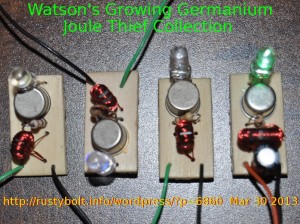 I went on a Joule Thief building binge for a few hours last night, making up some germanium Joule Thiefs after I found a small box of old unidentified germanium transistors that I had forgotten about. I used a small piece of the “Woodsies Squares” thin birch plywood about 1/2″ by 1″ (12.5 by 25 mm) that I got from the crafts store. I used the #60 wire size drill in a General #92 pin vise to drill the holes to mount the parts. The PNP germanium transistors had barely visible remnants of labels on the top; might have been Texas Instruments symbols.
I went on a Joule Thief building binge for a few hours last night, making up some germanium Joule Thiefs after I found a small box of old unidentified germanium transistors that I had forgotten about. I used a small piece of the “Woodsies Squares” thin birch plywood about 1/2″ by 1″ (12.5 by 25 mm) that I got from the crafts store. I used the #60 wire size drill in a General #92 pin vise to drill the holes to mount the parts. The PNP germanium transistors had barely visible remnants of labels on the top; might have been Texas Instruments symbols.
I got some of these transistors in a lot I bid on on eBay, for a very low price if I didn’t count the shipping (the seller, apparently not knowing what they were, called them resistors). The transistors are apparently from the first decade of the transistor, probably late fifties to early ’60s. They measured low gain, so I used a lower value resistor, 390 ohms for one JT, 470 and 560 ohms for the others. I haven’t completely assembled the third one, which will probably have another 470 ohm resistor. I had several germanium JTs working, but none were neatly assembled on a board, they were just tack soldered together.
I used T231212T cores from Surplussales.com, with three conductors of 30 AWG solid enameled wire, about 6-1/2″ (17cm) long wound trifilar. I paralleled two of the three to make the primary and the remaining single winding became the feedback winding. What really has me puzzled is why I had such a large discrepancy in the three coils I wound. All three cores were pulled from the same bag. I wound all three coils identical, with about 6-1/2 inches of the same 30 AWG wire, trifilar. They all had about the same number of turns. Two of the coils measured 105 to 115 microhenrys, while the third measured 440 uH, almost four times higher. My thoughts were that the seller had dumped more than one type of core into the same bag and mixed them up, so that they were actually selling two (or more) different cores as the same part number. Or another theory might be that the manufacturer was selling this as floor sweepings or rejects, and the seller was hiding the fact that the parts were not new. Whatever the case, I may have to go through the whole bag of them and test each one, because I have several dozen still left in the bag.
This morning, Mar 29, I dumped a bunch of the cores out and started measuring each one by slipping a short length of resistor lead in the clips of the LC meter through each core. This single turn measurement showed about 2 to 2.5 uH for most of the cores, but there was a pile of 20 or more that were ‘substandard’, many measured below 2 uH, some between 1 and 1.8 uH. Those were definitely out of tolerance so I bagged them separately and labeled them rejects. They’re okay for a Joule Thief, they just have lower inductance, that’s all. But still the seller gave the specs and these rejects clearly don’t meet them.
In the picture the second from the left LED is glowing dimly, and the far right green LED is lit up brightly. This is connected to a Rayovac ‘Heavy Duty’ C cell that was purchased almost 25 years ago. Before I put it on the JT, it measured 1.52 V, less than when it was when new, but still good for lighting up the JT’s LED.
How do the Germanium ones perform? Does the low voltage performance justify their use?
The germanium transistors I have are old, and their current gains are about 40 to 60, which is 1/6 or less of the typical silicon transistor. The base bias resistor I’m using is 390 to 560 ohms, mainly to compensate for the low gain. Even then it doesn’t draw all that much current, well under 100 mA. So performance-wise they’re nothing compared to silicon.
But the silicon JT will stop when the cell is at a half volt, and then I can put it into a germanium JT and it will run for hours more until it’s barely glowing at somewhere around 0.2V. Then if I let it be, the LED may not be lit but it’s still drawing current and a week later the cell may measure 0.1V or even less. By then it’s definitely ready for the trash can.